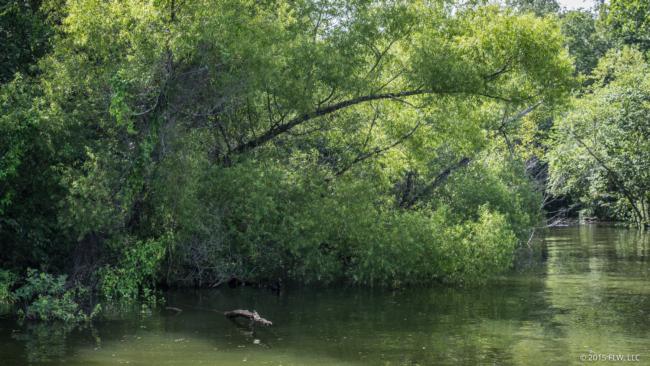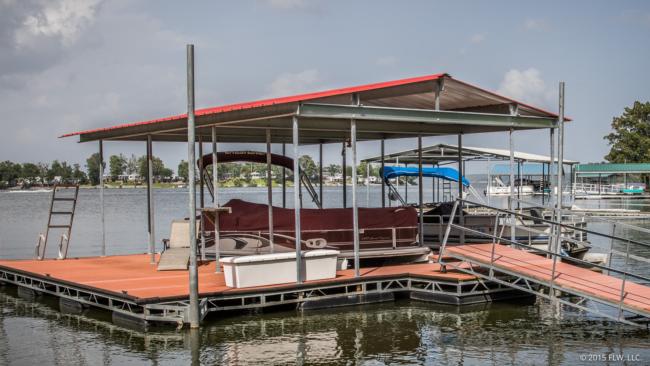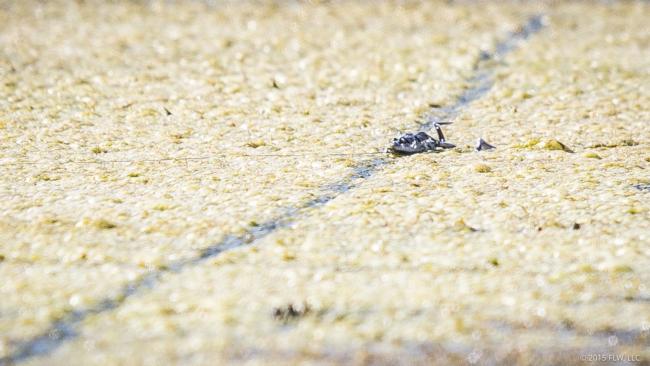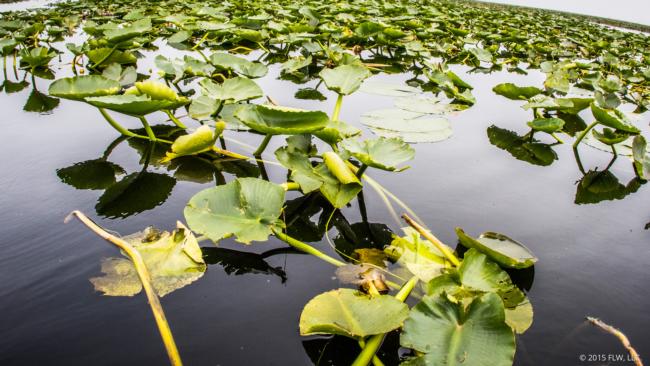5 Frog Tactics that Work Now
Get your ribbit on this summer with these floating frog patterns
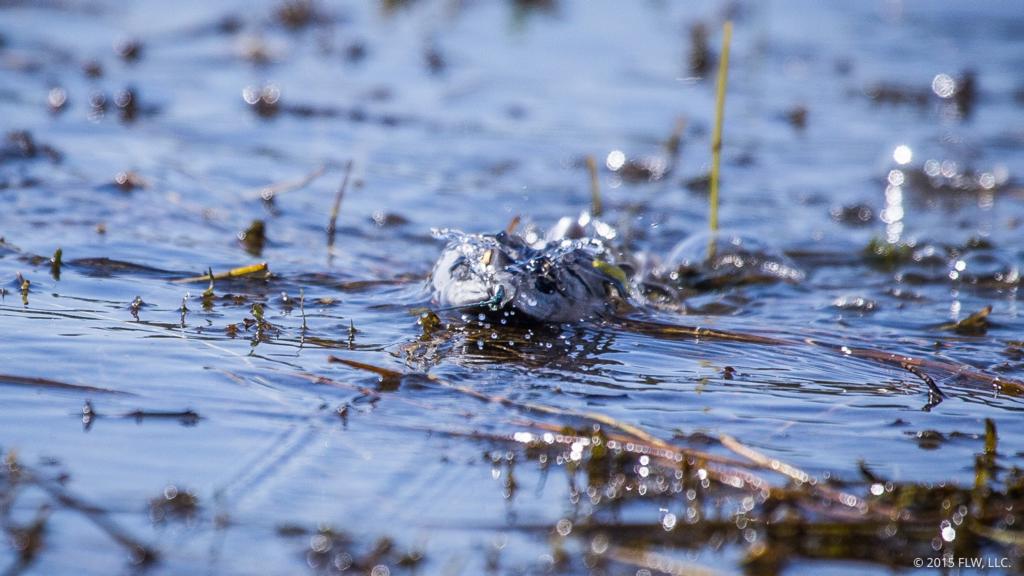
Any day that you can catch bass on a frog is a good day. The bites are visual and often explosive, and frogs provide a unique opportunity to pair a topwater lure with heavy rods and braided line.
Beyond the simple joy of slamming hooks into the mouth of a shallow, surface-feeding bass, frogs also offer technical advantages that allow anglers to capitalize on some of the best big-bass action of the summer.
To learn more, we asked five Walmart FLW Tour pros to detail their favorite summer frog patterns. You can put their tips to good use right now on just about any lake you fish.
Frogs 101
Technical Advantages
- – Avoid Snags – Frogs can be fished through, over or under just about anything because of their weedless design.
- – Skip Easy – Frogs are easy to skip thanks to their smooth, broad bellies.
- – Get Big Bites – Especially in summer, frogs produce big bites – although not necessarily a lot of bites. They’ve accounted for several Forrest Wood Cup victories, at least in part, in the last decade on places like the Red River (Randall Tharp, 2013), Lake Lanier (Jacob Wheeler, 2012) and Lake Murray (Michael Bennett, 2008).
What to Target
- – Shade – It doesn’t matter what casts the shadow, but having a shade line gives bass “cover” for ambushing prey in the summer, especially when the sun is high. Shade creates a predictable target for casting the frog. It was also the first element that every pro mentioned when asked about summer frogging. However, on overcast days, other frog patterns do develop.
- – Bait – For a bass to hold in the shallows in hot weather there must be bait. Most often, that bait is bluegills or another type of bream, but it could be young-of-the-year shad or other fishes too. According to pro Darrell Davis, bream are most vulnerable when they’re on the surface, so a frog lure overhead imitates an easy meal to a bass.
Tackle and Technique
- – Color – The pros don’t get too caught up on frog color. They use black or white almost all the time. More realistic frog colors such as green, brown or some combination also work well.
- – Style – In this instance, we’re talking about floating, weedless, hollow-body frogs, not buzz frogs. The former comes in two styles: popping or “regular.” Both work in most scenarios, though pros tend to choose a regular frog when fishing thick mats.
- – Action – It’s important to learn to walk a frog side-to-side so that it has action, but doesn’t move forward too quickly. Walking the bait keeps it moving, but also keeps it in the strike zone longer. The trick is to maintain slack in the line and to “pop” that slack with the rod tip during the walking cadence. Other retrieves work too, but this is the preferred method of the pros. If you’re having trouble, try a popping frog, which is often easier to walk.
The Patterns
1. Overhanging Branches, Flooded Bushes, Willows and Mayflies
South Carolina pro Brandon Cobb has a frog tied on year-round, but in the summer he’s almost always targeting bass feeding on bream in shady areas created by willow trees, bushes and other bank cover. The cover might be in the water, or it might be hanging out over the water from the bank. In either case, the water is always shallow – 1 to 3 feet deep – and Cobb does most of his damage in the backs of creeks.
“A lot of times they [the bream] are spawning and I target their beds, but usually this late in the summer that’s over [in South Carolina] and I’m fishing dirtier water,” Cobb says. “Also, where mayfly hatches occur the bream will get in the same bushes to eat the mayflies, and the bass will follow.”
Mayfly hatches typically occur early in the summer in Cobb’s part of the country, but they linger on throughout the season in other regions. A mayfly hatch can also occur over a three- or four-week period in different areas of a lake. Cobb doesn’t go looking for mayflies, but considers shady areas with hatching mayflies to be targets of opportunity whenever he comes to them.
Cobb’s preferred frog is the SPRO Bronzeye Frog fished on 65-pound-test braid with a 7-foot, 1-inch heavy-action Powell rod for skipping in tight quarters or a 7-3 rod in more open water.
“I fish it a lot faster than a lot of people,” he adds. “I walk it and try to cover a lot of water with it but fish it in the key area on each cast. I fish it through the shade and a foot or two out past the shade line.”
2. Boat Dock Walkways
Boat docks are prime overhead cover for summer fishing, but Kentucky pro Terry Bolton often dials in his dock pattern farther than that and specifically targets the shadows created by walkways that connect floating docks to the bank. This is the pattern that produced a third-place finish for Bolton at the Forrest Wood Cup on Lake Murray in 2008.
“I caught the biggest fish of the second day [on Lake Murray],” Bolton recalls. “It weighed over 6 pounds, and I caught it underneath a boat dock walkway where the ramp connected to the dock.”
The shade created by the walkway creates a defined target for a topwater approach.
“I’ll usually skip under it, and depending on the direction I’m coming, I’ll either target where the walkway connects to the dock or where the walkway leaves the bank,” Bolton says. “I’ll walk the frog back and forth and generally always keep the bait coming, though sometimes I’ll pause it.”
Bolton’s Cup pattern was to target small pockets off the main river channel, where the depth varied slightly from pocket to pocket but was usually only a few feet.
His favorite frog is a new model from Terminator called the Walking Frog with 3/4 to 1 inch of the tails trimmed off. He throws black on a sunny day and white on a cloudy day. Bolton spools up with 65-pound-test Sufix 832 braid on a 7-foot, 2-inch, medium-heavy Lew’s Custom Speed Stick “magnum bass” rod.
3. Bank Grass
Various types of emergent bank grass grow along the shores of reservoirs throughout the country. Some grow in the first foot or two of water, while others grow on the bank and are eventually flooded when the water rises. Either type of grass becomes the frogging target of West Virginia pro Ryan Davidson once the water temperature reaches the mid-80s.
“Where I live we don’t have docks,” Davidson says. “And we have don’t necessarily have a lot of submergent grass like hydrilla or milfoil, but we have bank grass, and we fish bank grass mostly in low-light conditions. We key on the grass edge in low light, but once the sun is high in the sky or on a bright day we transition more to shade lines.”
Davidson prefers to target isolated patches of grass that are 10 to 20 feet wide because he can fish them quickly – five casts and he moves to the next one, casting to as many as he can in a day. Some of his most productive spots are where an emergent grass bed meets up with a submergent grass called muskgrass, which grows short along the bottom and has a distinct odor. Bass will work the seam where the two types of vegetation meet.
“They get extremely shallow in late summer,” he adds. “They spawn and are up from late May to early June. Around Memorial Day they go deep. Once it gets really hot by the end of July, our fish go extremely shallow. That’s where the frog gets really good. Once it happens, nobody wins tournaments in reservoirs out deep. Everything from then until fall gets won in under 2 feet of water.”
Davidson only throws popping frogs because he says he can do anything with a popping frog that he can with a “regular frog,” plus he can chug it. His favorite is the BOOYAH Poppin’ Pad Crasher in leopard frog (green, yellow and white) or black. He fishes the frog on 50-pound-test PowerPro Super 8 Slick braid and a Megabass Orochi XX 6 1/2-power (medium heavy), 7-foot worm and jig rod.
4. Slop
Slop, cheese, scum, slime – whatever you call it, when a grass bed mats up and grows a layer of slimy goo, it’s just about right for a frog. The key is for the mat to thicken up enough that it blocks the sun, killing some grass underneath to open up “caverns” where bass can hunt.
In Chad Grigsby’s home turf of Minnesota, and also in Michigan where he grew up, the mats get right in July in just 2 or 3 feet of water. That’s when he pulls out a Live Target Frog.
“You have to cover water, but you get a lot of bites in holes [in the mat], or in little pockets,” he says. “Bass can kind of follow it from beneath. Sometimes you’ll see them make a wake underneath the mat, and when you get to that open hole you just kind of kill it. If he’s on it, you’ll get him there.”
Grigsby likes to fish as much or as many of the mats as he can until he gets a bite or two, and then he slows down and picks apart the area where the fish showed themselves.
“For whatever reason, it’s like they’re here or they’re there,” he says. “They’re all ganged up together. There could be five or six or seven. And you can go back to that waypoint later and get a bite. I think that has a lot to do with the bottom content.”
Grigsby trims his frog’s tails and occasionally swaps out hooks for longer models. In the thickest mats, he weights his frog by adding 10 or so small glass rattles. The extra weight makes the frog press into the mat, so bass can draw a better bead on it.
His frog setup is 65-pound-test Seaguar braid and a 7-foot, 6-inch Halo medium or medium-heavy rod. He likes the lighter one if he’s going to be fishing the frog all day because it causes less fatigue.
5. Lily Pads
Frogs and lily pads, spaghetti and meatballs – they just go together. For Darrell Davis, lily pads are prime, but when to fish them depends on the depth.
In water that’s 2 to 3 feet deep, Davis targets pads during bluegill spawns.
“There needs to be a good mussel bar or good sandy bottom under those pads for bluegills to be there,” he says.
In water that’s 4 to 6 feet deep, the bluegills will stay under the pads whether they’re spawning or not.
Davis has a few tricks for dialing in on the most productive parts of a pad field too.
“I just try to find the sandiest part of it,” he says. “I also listen for the bluegills and smell for them. They have a distinct small. It’s definitely something you have to acquire, but I can pretty much smell if bluegills are present because I’ve been doing it for so many years. If no bluegills are present, look for any kind of bait movement.”
Davis chooses a frog that closely matches the color of the local bluegills – usually darker during a spawn and lighter otherwise. He likes the SPRO Bronzeye Pop, which he can fish slowly with a pop-and-stop retrieve in open holes in the pads, or a Reaction Innovations Swamp Donkey in thicker fields.
“I don’t want to move it a lot because the more you let it sit the better off you are,” he says. “Barely pop it.
“I’ll usually fan-cast in a lily pad field as much as 15 to 20 feet apart,” Davis adds. “If I see movement I’ll space my casts 3 or 4 feet apart, but I cover a lot of water at first.”
The Florida pro’s tackle setup is a 7-foot, 6-inch heavy-action rod with 65-pound-test braid.
